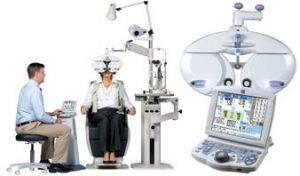Dr. Schmidt and his team are dedicated to providing the most advanced, comprehensive eye care to optimize your visual function. Schmidt Family Eye Care provides advanced, comprehensive care for a wide array of visual problems. Utilizing the latest technology, we treat the following conditions:
- Cataracts
- Glaucoma
- Diabetic retinopathy
- Corneal diseases
- Dry eye disorders
- Many more
TRS 5100 Electronic Refractor from Marco
 The TRS 5100 benefits from Marco’s latest generation of electronic refraction technology. Replacing the standard refractor, it allows practitioners to control the entire refraction process from a keypad small enough to sit in the lap. This keypad also controls the CP-690 Automatic Chart Projector. And because the TRS 5100 is completely programmable, all the lenses are moved at the touch of a button, taking to each new refraction step. While convenient, it is also helpful if delegate refractions and want the technicians to perform the refraction steps in a specific order.
The TRS 5100 benefits from Marco’s latest generation of electronic refraction technology. Replacing the standard refractor, it allows practitioners to control the entire refraction process from a keypad small enough to sit in the lap. This keypad also controls the CP-690 Automatic Chart Projector. And because the TRS 5100 is completely programmable, all the lenses are moved at the touch of a button, taking to each new refraction step. While convenient, it is also helpful if delegate refractions and want the technicians to perform the refraction steps in a specific order.
Digital Retinal Imaging
We use cutting-edge digital imaging technology to assess your eyes. Many eye diseases, if detected at an early stage, can be treated successfully without total loss of vision. Your retinal Images will be stored electronically. This gives the eye doctor a permanent record of the condition and state of your retina.
This is very important in assisting your Optometrist to detect and measure any changes to your retina each time you get your eyes examined, as many eye conditions, such as glaucoma, diabetic retinopathy and macular degeneration are diagnosed by detecting changes over time.
The advantages of digital imaging include:
- Quick, safe, non-invasive and painless
- Provides detailed images of your retina and sub-surface of your eyes
- Provides instant, direct imaging of the form and structure of eye tissue
- Image resolution is extremely high quality
- Uses eye-safe near-infra-red light
- No patient prep required
Digital Retinal Imaging allows your eye doctor to evaluate the health of the back of your eye, the retina. It is critical to confirm the health of the retina, optic nerve and other retinal structures. The digital camera snaps a high-resolution digital picture of your retina. This picture clearly shows the health of your eyes and is used as a baseline to track any changes in your eyes in future eye examinations.
Visual Field Testing
A visual field test measures the range of your peripheral or “side” vision to assess whether you have any blind spots (scotomas), peripheral vision loss or visual field abnormalities. It is a straightforward and painless test that does not involve eye drops but does involve the patient’s ability to understand and follow instructions.
An initial visual field screening can be carried out by the optometrist by asking you to keep your gaze fixed on a central object, covering one eye and having you describe what you see at the periphery of your field of view. For a more comprehensive assessment, special equipment might be used to test your visual field. In one such test, you place your chin on a chin rest and look ahead. Lights are flashed on, and you have to press a button whenever you see the light. The lights are bright or dim at different stages of the test. Some of the flashes are purely to check you are concentrating. Each eye is tested separately and the entire test takes 15-45 minutes. These machines can create a computerized map out your visual field to identify if and where you have any deficiencies.


Please note: By appointment only!